| |
News...
| 14.10.2025 |
| | |
|
Congratulations to Dominik Milacher and Elias Wachmann, who just defended their Master Theses recently with great success. Both were working on attempts to speed up convergence in electronic structure calculations via machine-learned initial guesses. Talking about speed, both had little time to waste regarding their career: congrats on your new jobs!
|
| 02.07.2025 |
| | 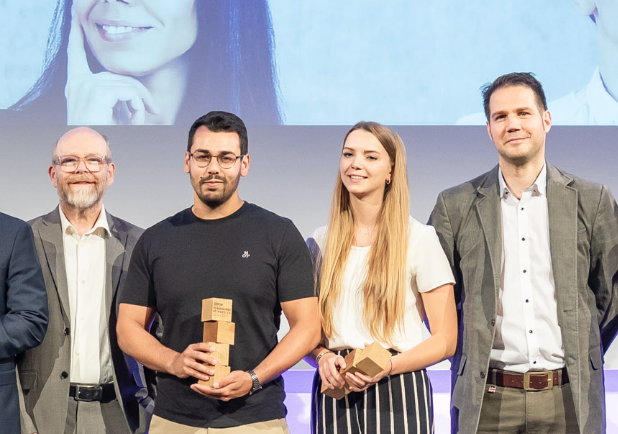 |
|
Today Gerda Langer received a sholarship from the Austrian Economic Chamber (WKO) for her "crossover" Master Thesis on Physics-Informed Neural Networks for Applications in Quantum Chemistry and Thermodynamics. She even made it to the movies (starting at 8:36)! Congratulations Gerda, and all the best for your future undertakings! (Copyright: picture - Foto Frischer, video - frischenschlager.tv)
|
| 12.06.2024 |
| | 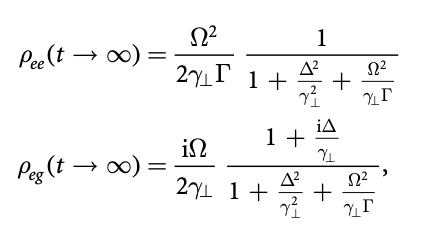 |
|
Our article on a molecular version of "Optical" Nuclear Electric Resonance has been published today in Physica Scripta. In LiNa, it should be possible to address the nuclear spin of Li or Na with pulsed laserlight of the same wavelength, but at a different repetition rates... Interesting concept? Have a look at our findings!
|
| 11.06.2024 |
| |  |
|
Today the TU Graz Media Service published a brief news report on the findings of our recent JACS article. As a reaction, a colleage wrote me today, suggesting that the motion might actually be more Salsa- than Rumba-like. Fair point, and an ongoing scientific debate... I really hope we can get some experimentalists on board soon for first tests in the lab!
|
| 15.05.2024 |
| | 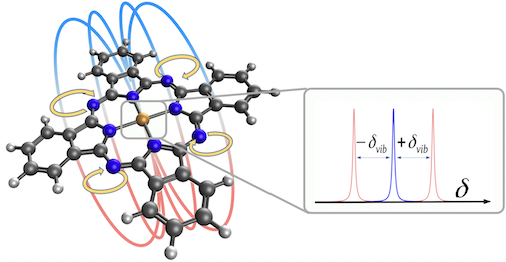 |
|
The first milestone of our ongoing FWF project [10.55776/P36903] on vibrationally induced magnetism has been achieved - in our latest article, published in JACS, we postulate that molecular magnetic fields, created by a concerted excitation of two degnerate vibrational modes, may be controlled (on/off and direction) by IR light. We chose phtalocyanine as our molecular template, give suggestions for suitable wavelengths, and make predictions for NMR chemical shifts which may serve as a tool for the experimental confirmation. Congratulations to Raphael, Johannes and Matthias!
|
| 11.03.2024 |
| | 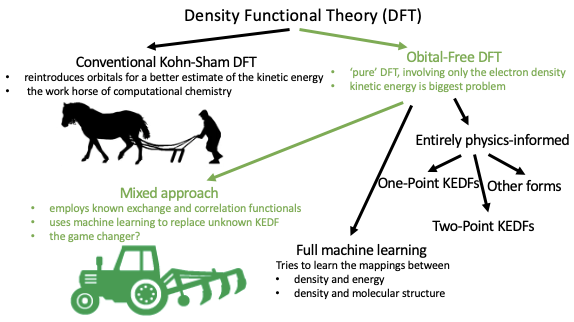 |
|
I was asked to write a comment in Nature Computational Science on a recent article dealing with Orbital-Free Density Functional Theory for molecular systems. I consider these findings a considerable advance in computational chemistry, as chemical accuracy can now be achieved. This might open access to quantum treatments of structures of biological interest such as enzymes or even subcellular components. What do you think - is this the dawning of a new era?
|
| 9.11.2023 |
| | 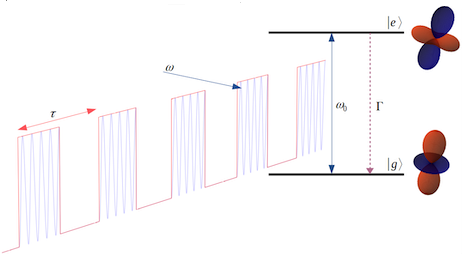 |
|
In a recent publication in Phys. Rev. A we present a new technique named "ONER" for the addressing of nuclear spins: via a controlled coupling of the nuclear electric quadrupole to a repeated modulation of the electronic density distribution (through electronic excitation in the uv/visible with pulsed laser light) it is possible to change nuclear spin states! Maybe this is the beginning of a new technology for nuclear spin manipulation in quantum computing? Have a look!
|
| 13.7.2023 |
| | 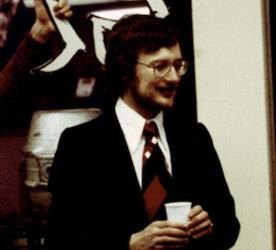 |
|
The Wolfgang E. Ernst Festschrift on the occasion of his 70th birthday is out - a highly diverse collection of PCCP articles covering the fields of molecular physics, metallic nanoparticles, helium droplets, surface science and spectroscopy, published by the Royal Society of Chemistry. Dear Wolfgang, congratulations and all the best wishes! With your broad interest in all sorts of topics and your personal motivation you have been an inspiration to many generations of scientists. We thank you for your guidance and your advice throughout the years.
|
| 7.7.2023 |
| | 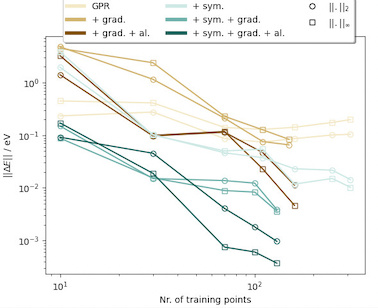 |
|
Our latest article on symmetry- and gradient-enhanced Gaussian Process Regression is out! It is part of the JCP Special Issue themed "Machine Learning Hits Molecular Simulations" . In this article we developed an algorithm that is particularly well suited for molecular problems where a rigid molecule is embedded in some highly symmetric molecular environment, e.g. a MOF or some other porous structure, and can also be used for permeability calculations through 2D membranes. Congratulations to Johannes and Christian!
|
| 19.5.2023 |
| | 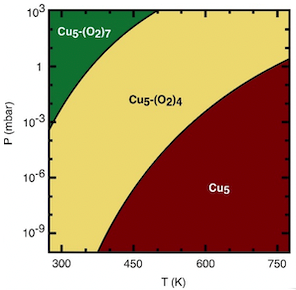 |
|
Our joint efforts involving four countries on two continents have led to an insightful article on the stability and reactivity of sub-nanometer copper clusters. In the mixed theoretical and experimental paper we investigate the thermal stability of Cu5 clusters and their suceptibility to oxidation. Interestingly, they are stable up to almost 800 K, a fact that we are attributing to a combination of charge transfer processes and large-amplitude vibrational motions that do not compromise the structural integrity of this quantum object with features somewhere between molecule and metallic system.
|
| 23.3.2023 |
| |  |
|
Congrats to Johannes Krondorfer, who just defended his excellent Master Thesis on nuclear quadrupole resonance effects in confined quantum systems, investigating ways to address nuclear spins through couplings via the electric field gradient tensor. Highly motivated and absolutely fearless when it comes to symbolical maths - it hurts to see a student like him leave the group, but we wish him all the best for all his future undertakings!
|
| 30.9.2022 |
| | 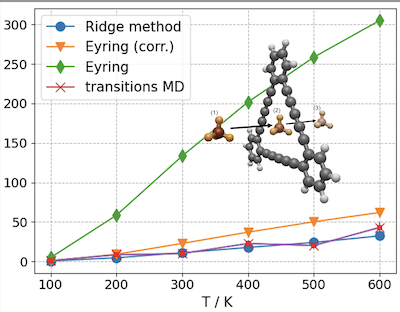 |
|
In a recent publication on gas separation via graphdiyene as a porous 2D membrane we introduced a new method for the calculation of permeance and selectivity based on efficient evaluations of the partition sums involved. We show that transition state theory is problematic in these cases, and MD simulations are too costly since pore crossings are statistically very rare events. Hopefully, the code we developed will be useful to others in the future. Code extensions and improved docs are planned. Congrats to Christian and Johannes for their stamina with this publication!
|
| 17.3.2022 |
| | 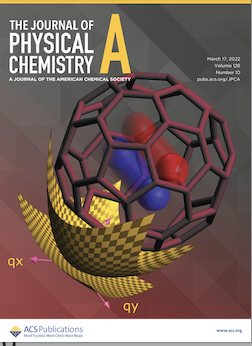 |
|
In our latest article we predict a new type of non-adiabatic coupling, highly similar to the Renner-Teller effect, but affecting the translational (!) modes of diatomic molecules in a highly symmetric confining potential. Possible realizations are endofullerenes, and the candidate we studied, NO@C60, found its way onto the cover of JPCA! Hopefully, experimentalists will be able to confirm this effect soon...
|
| 23.7.2021 |
| | 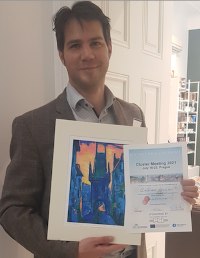 |
|
Just back from the first real-world meeting after such a long time, the Cluster Meeting 2021 in Prague, hosted by the group of Stefan Vajda. A very interesting and diverse conference with a nice mix of theory and experiments in cluster physics. Thanks to Stefan, Armin and Alessandro for organzing such a great event.
Our oral contribution was even elected "Best Hot Topic Talk", which shows that we are on an interesting path! Thanks to Ralf, Klemens, Manuel and Daniel for their hard work which I was allowed to present.
|
| 29.4.2021 |
| | 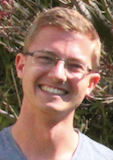 |
|
Yet another graduation to celebrate: Today Ralf Meyer sucessfully defended his PhD-Thesis on machine learning in computational chemistry with an amazing performance. A hot topic and very broad field, but Ralf managed to keep the overview and provided contributions to geometry optimization, transition state search and orbital-free DFT. Congrats Ralf, and good luck for your academic career! For those readers who are on the lookout for a competent postdoc: I think it's your lucky day...
|
| 17.8.2020 |
| | 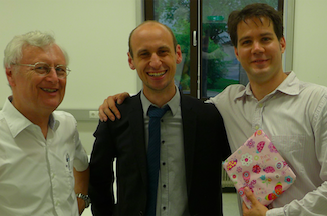 |
|
To be or not to be (alloyed): Today Martin Schnedlitz sucessfully defended his PhD-Thesis on the structural behavior of mixed-metallic nanoparticles. Congrats Martin, and the best of luck for your future endeavors!
|
| 10.8.2020 |
| | 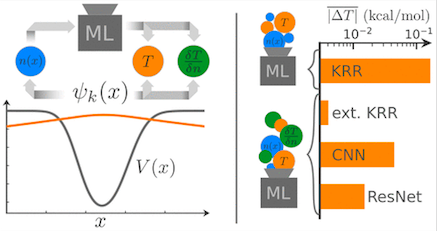 |
|
Please have a look at our latest article in JCTC on Machine Learning in Computational Chemistry: On the long and winding road toward orbital-free DFT we expand on the earlier ideas of learning the kinetic energy density functional with kernel ridge regression, including now also the functional derivative, and comparing its performance to a bunch of pretty fancy neural networks... Congrats to Ralf and Manuel for this detailed and elaborate piece of work!
|
| 9.7.2020 |
| | 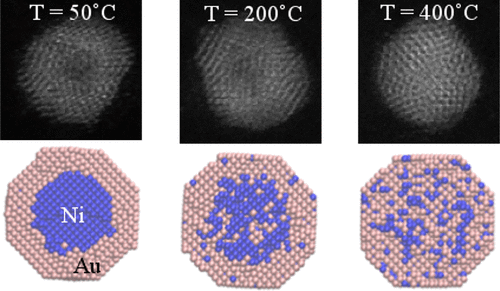 |
|
Our JPCC article on the surprisingly different structural featurs of Fe- Co- and Ni-Au core@shell nanoparticles just went online, yet another outcome of our collaboration with the group of María Pilar de Lara-Castells at the C.S.I.C. Madrid.
|
| 27.2.2020 |
| | 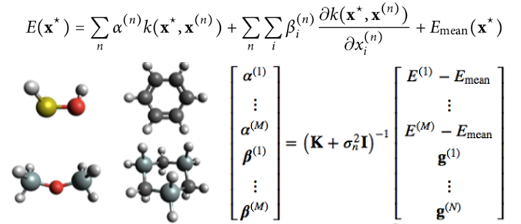 |
|
In our latest JCP article on machine learning techniques in computational chemistry we investigated the combination of well-established internal coordinate systems with Gaussian process regression for geometry optimizations of molecular systems. Typically, the latter ML approach is combined with Cartesian coordinates because it's more convenient, but with internals there is more to gain! Nice work Ralf, congratulations!
|
| 2.10.2019 |
| | 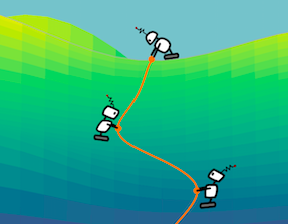 |
|
Our JCTC article on machine learning-enhanced searches for transition states just came out - congratulations to Ralf and Klemens! As it turns out, Gaussian Process Regression is a very efficient and easily realized method to accelerate those costly searches we all know too well... Next time, let our little robots help you find your reaction path! We hope to have this implemented soon in Q-Chem.
|
| 29.8.2019 |
| | 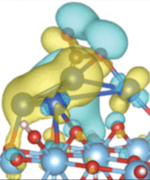 |
|
Our collaboration with the group of María Pilar de Lara-Castells at the C.S.I.C. Madrid led to a publication in JPCC on the ability of sub-nanometer-sized Cu5 particles on TIO2 to activate carbon dioxide. Maybe this can be combined somehow with the enhanced photoadsorption we found for the same material (see here) for photocatalysis with sunlight!
|
| 7.8.2019 |
| | 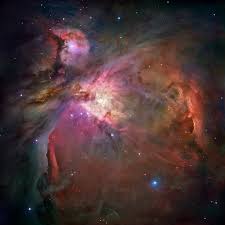 |
|
What does the spectroscopy of helium-immsered molecules have to do with questions concerning the origin of life in the universe ?
Find out by reading the comment of Dr. de Lara-Castells and myself on the review article of Barone and Puzzarini published in Elsevier's Physics of Life Reviews.
|
| 22.4.2019 |
| | 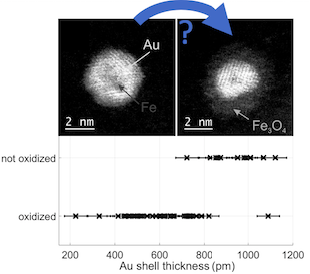 |
|
Rusting on the nanoscale: In a joint effort with the Ernst group we could determine the number of atomic layers of gold necessary to protect a Fe nanoparticle from oxidation, see our mixed theory/experimental article in Nanoscale Advances.
|
| 25.2.2019 |
| | 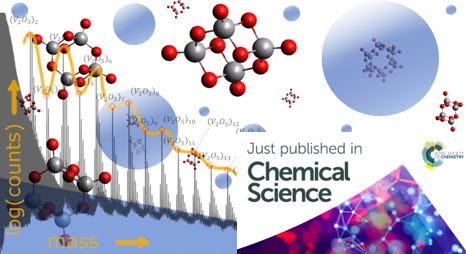 |
|
Yet another team success! Together with the Ernst group we could show that solid vanadium pentoxide evaporates preferably in units of (V2O5)2 when heated. This means that the stoichiometry is not affected and might open new ways of nanostructure coating with this SCR catalyst.
Have a look at our latest publication in RSC Chemical Science. We even made it to the back cover of the issue!
|
| 16.2.2019 |
| | 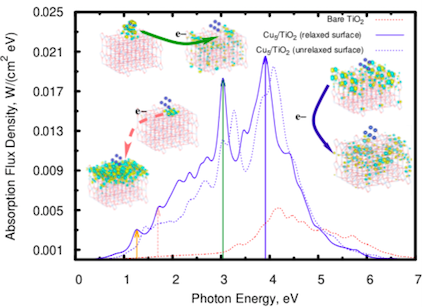 |
|
Our collaboration with the group of María Pilar de Lara-Castells at the C.S.I.C. Madrid and the NANOMAG-team of Manuel Arturo Lopez-Quintela at the University of Santiago de Compostela on smallest copper clusters and their effect on the optical properties of TiO2 led to a publication in ACS Journal of Materials Chemistry A! The highly stable Cu5 clusters enhance the adsorption of photons and shift the absorption spectra towards the visible. This is a big step forward towards harvesting solar energy for follow-up surface reactions; maybe we can link this to some relevant photocatalysis in the next step.
|
| 2.10.2018 |
| | 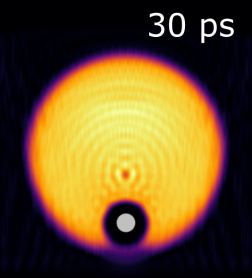 |
|
With joint forces to Nature Communications! What is really going on if you excite an atom inside a quantum solvent? Find out by clicking the link above. We congratulate the team of Prof. Koch on their recent experimental success and are very happy that we could contribute a little theory to this breakthrough. See the press release for more information!
|
| 18.6.2018 |
| | 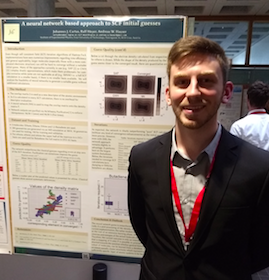 |
|
Our team is back from the "Computational Chemistry meets Artificial Intelligence" or CC2AI meeting 2018 in Lausanne, where Ralf was giving a talk and Klemens, Alexander and Johannes were presenting their posters. Great news: Johannes Cartus won the poster prize for the presentation of his work on "A Neural Network based approach towards SCF guesses". Was it the jacket? Anyway, congratulations!
|
| 4.6.2018 |
| | 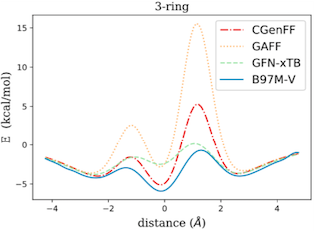 |
|
Finally, we could dedicate some time again to our work on chiral separation via 2D membranes. A follow-up study in Chem.Phys.Chem. on candidate materials and computatational strategies to estimate selectivities just went online. In the figure you see an approximate reaction pathway for a benchmarking scenario, the propagation of ethane through a graphene pore, evaulated with different methods. We also tested the new tight-binding program of the Grimme group, see here for details.
|
| 17.4.2018 |
| | 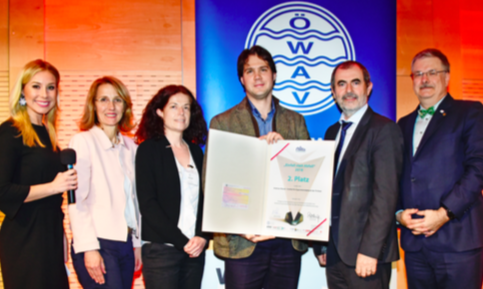 |
|
Our invention (patent pending, inventors A. Hauser and M. Koch), developed in a little side project, was awarded 2nd prize at the PHOENIX meeting in Salzburg. It's a machine for the separation of precious materials from waste, applicable to particles with diameters below one mm. Okay, that's not nanoparticles, but it can't be always "nano", can it?
|
| 9.1.2018 |
| | 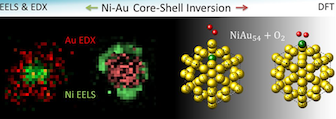 |
|
And yet another team success! This article on the structural inversion of NiAu core-shell nanoparticles upon heating and follow-up cooling has just been published at ACS Chemistry of Materials. Our research efforts are slowly invading the highly competitive nanomaterials sector! In this case, the alloying processes is enhanced by the presence of oxygen, which is also responsible for locking the particles in an oxidized nickel-shell and gold-core after a heating cycle.
|
| 9.1.2018 |
| | 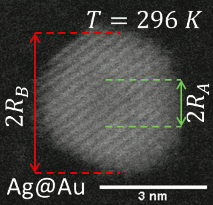 |
|
Sucess! Our long-term collaboration with the Ernst group and the FELMI on mixed-metallic nanoparticles led to a publication in RSC Nanoscale. Have a look at our results for the AgAu core-shell system. We study alloying processes in Ag@Au and Au@Ag particles with average radii of 2 nm and measure the the temperature-dependent diffusion constant at the nanoscale.
|
| 25.8.2017 |
| | 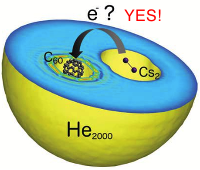 |
|
We could finally solve the puzzle about the interaction of C60 with Cs2 in superfluid helium! It is indeed a harpoon-type reaction where the electron is stolen by the fullerene. This is only possible for Cs2, where the crossing point of the ionic and the neutral PES takes place already at larger distances. For more details, please see our latest article in JPC Letters!
|
| 12.5.2017 |
| | |
|
This is something that caught out interest many years ago: The possibility of forming Rydberg superatoms via excitation of alkali atoms on He droplets. In this article we develop a new ansatz to make predictions for quantum numbers where a migration of the alkali atom into the droplet should become feasible while its valence electron still keeps spinning around the He droplet.
|
| 24.3.2017 |
| | |
|
Samuel Frühwirth defended his Master Thesis today, shining with a flawless talk and a sparkling performance in the exams. Congratulations Samuel, and good luck for all your future undertakings. We already miss your tongue-in-cheek approach to everything!
|
| 31.1.2017 |
| | 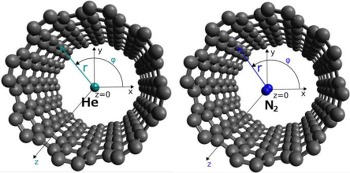 |
|
Our collaboration with the CSIC in Madrid is on fire! The third article of our series on He-interacting carbon structures has just been published at JPCC! It contains a more detailed study of the vibrational motion of He atoms inside a carbon nanotube and compares it to that of molecular nitrogen.
|
| 28.11.2016 |
| | 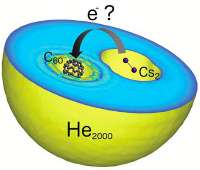 |
|
Our PCCP article on the interaction of C60 with Cs2 in superfluid helium made it online! This study was triggered by recent experiments of Paul Scheier and Andrew E. Ellis. It seems that a minimal charge transfer must occur despite the embedding in superfluid helium. The quenching lets Cs2 react but prevents a single Cs atom from approaching the fullerene.
|
| 15.11.2016 |
| | 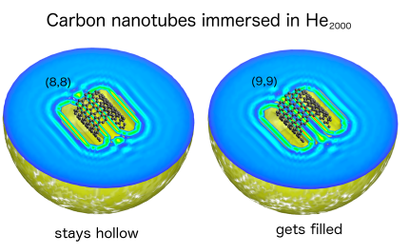 |
|
Our JPC Letter on carbon nanotubes immersed in superfluid helium got accepted! The tubes show a fascinating quantum phenomenon: They sink into the liquid but are only partly flooded, resembling an onion-like structure of He layers inside the tube due to zero-point energy effects. The size of the tube diameter determines the number of layers that fit into the tube, causing an axial cavity in some cases. Cool?
|
| 14.10.2016 |
| | |
|
The PiR project is on the news now, see derStandard.at. People seem to like Mozartkugeln. I am glad we did not take Toffifee or Raffaello. It was a tough call though.
|
| 12.10.2016 |
| | |
|
Good news again! We also got funding for our project "Heterogeneous catalysis on metallic nanoparticles: Force field development based on machine learning" from the FWF! This is a good month indeed... |
| 5.10.2016 |
| | 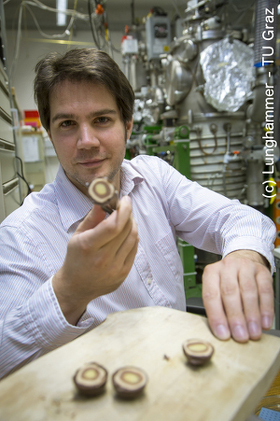 |
|
We got a prestigious 'Partnership in Research'-Grant for our project on Nano-Mozartkugeln ! The Partnership in Research (PiR) programme of the Christian Doppler Gesellschaft is designed to encourage new partnerships between research and the business world, see here for more info. It's a one-off programme carried out in cooperation with the FWF. It's going to be a tight collaboration with the Ernst group. We are looking for PhD and master students now, please scroll down for more info.
|
| 23.9.2016 |
| | |
|
Ralf Meyer defended his Master Thesis today and gave a stunning performance. Congratulations Ralf, very impressive!
|
| 11.5.2016 |
| | 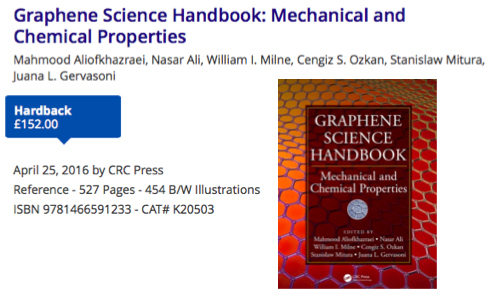 |
|
The Graphene Science Handbook is out, and with it our contribution! CRC managed to publish the 6-book series finally. Check out chapter 25 of the third book!
|
| 6.11.2015 |
| | 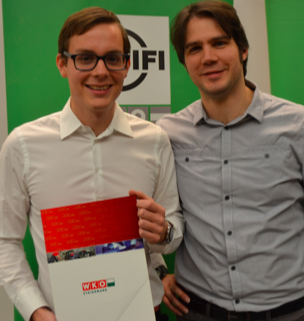 |
|
Samuel Frühwirth won a scholarship from the WKO (Wirtschafts- kammer Österreich) for his ongoing diploma thesis project entitled "Development of a novel, membrane-based method for chiral separation in the pharmaceutical industries". Congratulations!
|
| 10.3.2015 |
| | 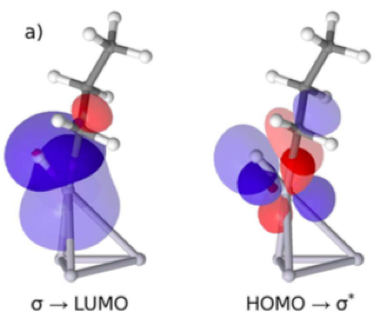 |
|
Our PCCP article on the dehydrogenation of alkanes over bimetallic nanoparticles went online today.
|

Open PhD positions 2026

Master projects 2026
Projekt VIMO_26M (financed via FWF Project P-36903):
Metal phthalocyanines, a highly versatile class of aromatic, planar, macrocyclic molecules with a chelated central metal ion, are topical objects of ongoing research and particularly interesting due to their magnetic properties. However, while current focus lies almost exclusively on spin-Zeeman-related effects, the high symmetry of the molecule and its circular shape suggests the exploitation of light-induced excitation of twofold degenerate vibrational states in order to generate, switch and manipulate magnetic fields at the nanoscale.
The master student will be entrusted with the benchmarking of standard electronic structure codes (Molpro, Q-Chem, VASP) and a novel tight-binding program package, the GFN-xTB code of the Grimme group, on molcular structures of interest within this context, including a comparison to alternative force-field methods. This comparative study will comprise geometry comparisons, vibrational frequencies and infrared spectra, fractional charges of various types of population analysis, expectation values of the electronic wavefunction such as multipole moments, NMR predictions, susceptibilities and chemical shieldings, as well as detailed cuts through the potential energy surfaces along the vibrational modes of interest. As a part of the in-depth analysis of molecular expectation values, the student will further attempt the visualization of electronic charge fluctuations upon molecular vibration, with the goal to derive the corresponding magnetic field that is created by the pseudorotational motion.
In the final phase, the student might be extending his or her efforts towards the modelling of vibrational dynamics, preferably through the development of an interface for the GFN-xTB suite of programs, or via common packages such as LAMMPS. This involves the coding of suitable extensions and scripts, preferably in Python or Matlab, which allow for a simulation of vibrational motion in the presence of time-dependent electric fields.
Projekt INDI_26M
In the course of this joint master thesis, a collaboration between the groups of Prof. Koch and Prof. Hauser, the highly unusual behavior of indium dimers (In2) in droplets of superfluid helium is studied in theory and experiment.
While being mostly concerned with the computational aspects of molecular dynamics simulations and electronic structure theory, the interested student will also be exposed to the most recent experimental data regarding the highly topical problem of time-resolved wave packet excitation in a molecular quantum system. Vibrational wave packets, triggered through ultra-short laser pulses, can be thought of as localized nuclear wavefunctions travelling on the molecular potential energy surface (PES). In particularly “exciting” cases – from a scientific point of view – the motion of such a wave packet might involve more than one PES. In other words, electronic and vibrational degrees of freedom are coupled in these systems.
The interested candidate will be performing calculations of electronically excited states, using multi-reference configuration interaction and many-body perturbation theory, mostly through the MOLPRO suite of programs. This way, the candidate will get exposed to the latest tools of modern computational chemistry and molecular physics. For the ‘grand finale’, the investigation of system dynamics, independent and creative code development in Python or MATLAB will be highly appreciated. An extension for the eager student, and particularly useful for ongoing research, could be the introduction of quantum effects caused by the solvent, e.g. through phenomenological approaches or methods based on helium density functional theory. . Please click here for more information.
Projekt REST_1_25M
Real-time electronic structure theory, a challenging, yet comparably less advanced subfield of computational chemistry, has gained substantially in interest in recent years due to experimental breakthroughs in the field of ultrafast spectroscopy on the atto- and femtosecond timescale. The theory aims for a realistic description and simulation of electron dynamics, by evolving either the Schrödinger equation or the Dirac equation in cases where relativistic effects become relevant.
By now, for almost all standard methods of computational chemistry there exists a time-dependent (TD) counterpart, for density- as well as wavefunction based methods, although of varying computational practicability and numerical accuracy. In the course of this master thesis, an atomic orbital-based ansatz within the real-time electronic propagation formulation will be applied to the Schrödinger equation for the electronic many-body problem. Starting from a well-known TD-Hartree-Fock framework, it is our goal to implement a cost-efficient TD-Configuration Interaction method for excited states based on the Python programming language. Somewhat challenging, but surely exciting as well ;)
Only basic programming skills in Python are required, but advanced knowledge would be highly appreciated. It is highly recommended for the candidate to participate in the lecture "Modelling of Molecular Systems" which will be held in WS. Please get in contact via mail if interested. A research support salary of 440 Euro will be paid for 6 months. This project will be exectued in a tight collaboration between the groups of Prof. Hauser and Prof. Schultze.

Bachelor projects 2026
Projekt PENDEL_26B:
Ein kommerziell erhältlicher Elektronik-Bausatz wird hinsichtlich seiner potentiellen Verwendungsweise für den Aufbau eines Focault-Pendels getestet. Es handelt sich um eine selbstverstärkende Schaukel, die Reibungsverluste durch einen periodisch aktivierten Elektromagneten kompensiert, der dem Pendel im Nulldurchgang einen zusätzlichen Impuls mitgibt. Es wird durch Aufbau zu testen sein, ob diese Art der Impulsgebung ohne Einflussnahme auf die Pendelebene möglich ist. Zur Positionsmessung des Pendels kommt ein Hall-Sensor zum Einsatz.
Die Bakk-Arbeit soll
- in der Einleitung Bezug nehmen auf das ursprüngliche Experiment von Leon Foucault,
- den Bausatz auf Eignung testen,
- eine theoretische Hochskalierung auf ein größeres Pendel wagen. Fall entsprechende Elektronik-Kenntnisse vorhanden sind oder das Interesse besteht, kann auch eine eigene Schaltung entworfen und getestet werden, die auch einen massiveren Pendelkörper in Schwingung halten kann.
Interessierte Studierende sollten ein wenig Erfahrung mit dem Lötkolben mitbringen; falls nicht vorhanden, wird aber einfach vorab an einem einfacheren Bausatz geübt.
Projekt KLIMA_26B:
Kann das Graviationsfeld der Erde dazu genützt werden, um den CO2-Gehalt der Umgebungsluft irgendwie vorzukonzentrieren? Welche Untersuchungen wurden bereits durchgeführt, und was ist das größte Problem bei dieser Herangehensweise? Diese Bachelorarbeit basiert auf der Recherche eines Ausgangsartikels aus dem Jahr 2019 zum Thema, seiner Überprüfung und der kritischen Betrachtung der Schlussfolgerungen. Welche Alternativen gibt es, um CO2 aus der Umgebungsluft abzutrennen, und welche Rolle spielt dabei die Entropie?
Projekt FULL_1_26B:
Berechnung der elektronischen Anregung von C60 und anderen Fullerenen, sowie die Interpretation der Anregungen mittels Molekülorbitaltheorie. Im Zuge dieser Arbeit erlernt der Kandidat bzw. die Kandidatin das Umgehen mit üblichen Elektronenstrukturtheorie-Programmen und muss sich mit Scripting in einer Unix/Linux-Umgebung auseinandersetzen.
Projekt FOLD_1_26B:
Literatur-Recherche zum Thema Proteinfaltung und Computer-Simulation von großen Molekülen. Analyse gängiger Kraftfeld-Ansätze, Einfluss von Machine-Learning Ansätzen der letzten Jahre. Hybrid-Methoden, Elektronenstrukturtheorie, Tight-Binding-Ansätze, Datenbanken, Großprojekte.
Projekt FIELD_26B:
Literatur-Recherche zum Thema Elektrische Felder und Chemische Reaktivität: Neue Entwicklungen zur Optimierung der Feldgeometrien bei chemischen Reaktionen. Ausgehen von einem Forschungsartikel, veröffentlicht im Jänner 2022, wird der gegenwärtige Stand der Forschung beleuchtet und neue Ansätze miteinander verglichen. Wie können Feldgeometrien in bestehende Geometrie-Optimierungen eingebaut werden? Wie kann man Übergangszustände aktiv stabilisieren?
Projekt HIST_26B:
Im reichen Fundus des Europäischen Zentrums für Physikgeschichte in Pöllau (Nähe Hartberg bei Graz) gibt es viele historische Geräte, deren Funktionsweise kaum dokumentiert oder in Extremfällen sogar gänzlich unbekannt ist. Interessierte Studierende der Physik können sich daher im Zuge einer Bachelorarbeit an den laufenden Aufarbeitungen sowie der Inventarisierung beteiligen. Neben der praktischen Arbeit vor Ort umfasst dies vor allem auch eine detailierte Recherche sowie die Diskussion einer eventuellen Aufnahme neuer Gerätschaften zu Demonstrationszwecken in laufende Lehrveranstaltungen oder andere Vorführungen.
Co-Supervisor und Betreuer vor Ort ist Ao. Prof. i.R. DI Dr. Gernot Pottlacher, der als ehemaliger Mitarbeiter am Institut für Experimentalphysik vor allem durch seine legendäre Serie von Weihnachtsvorlesungen auch einem größeren Publikum bekannt ist (Nächster Termin: 14.11.25, Schloss Pöllau).
Projekt DEMO_26B:
Die Durchführung von Experimenten ist ein essentieller Teil sämtlicher Einführungsvorlesungen in die Physik. Im Idealfall steht dafür ein ganzer Hörsaal mit allerlei Gerätschaften und Räumlichkeiten zur Verfügung; oft steht jedoch die Mobilität im Vordergrund, und der Anspruch verlagert sich hin zur maximalen Unterstützung des Verständnisses durch Experimente mit minimalem Geräte-Aufwand. Im Zuge dieser Bachelorarbeit soll versucht werden, eine Auswahl an klassischen Demonstrationsexperimenten inklusive Gerätschaften in möglichst miniaturisierter Form zu entwerfen. Hierbei sollte vor allem moderne 3D-Drucktechnik zur Anwendung kommen. Interessierte Studierende sollten daher bereits ein wenig Erfahrung mit 3D-Druckern haben und im Idealfall auch ein CAD-Programm zur Erstellung von 3D-Objekten beherrschen.

|
|










































